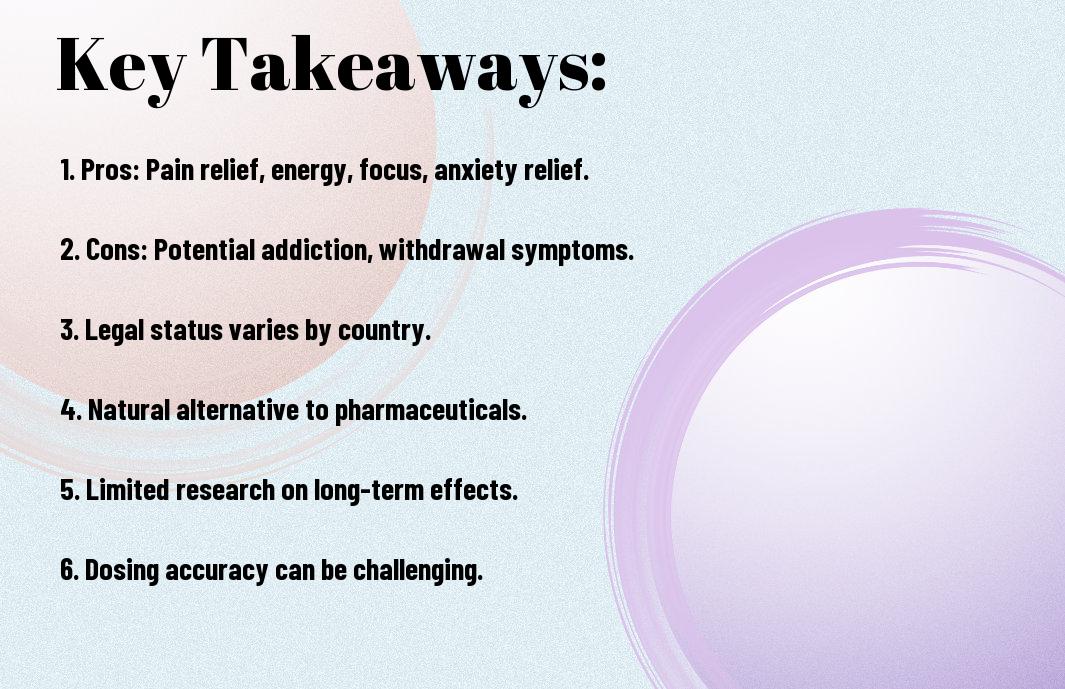With its lauded benefits and controversial drawbacks, kratom has garnered a mix of support and skepticism. The plant, hailed for its potential pain relief and mood-boosting properties, also raises concerns for addiction and dependency risks. Exploring the pros and cons of kratom is crucial for making informed decisions about its usage. Let’s probe into the complexities of this polarizing herb.
Key Takeaways:
- Pros: Kratom has been used traditionally in Southeast Asia for its stimulating and pain-relieving effects. It can also help manage opioid withdrawal symptoms and improve mood.
- Cons: Kratom comes with potential risks, including addiction, dependence, and withdrawal symptoms. Long-term use may also lead to health issues such as liver damage and cognitive impairments.
- Regulation: The regulatory status of kratom varies worldwide, with some countries banning it due to safety concerns. It is vital to be informed about the legal status and potential risks before considering its use.

History and Background of Kratom
Origins and Traditional Use
To understand the pros and cons of kratom, it is vital to explore into its origins and traditional use. Kratom, scientifically known as Mitragyna speciosa, is a tropical evergreen tree native to Southeast Asia, particularly in countries like Thailand, Indonesia, Malaysia, and Papua New Guinea. The leaves of the kratom tree have been used for centuries by locals for their stimulant and medicinal properties. In traditional settings, kratom leaves were chewed or brewed into tea to boost energy levels, alleviate pain, and improve mood.
Modern Popularity and Legal Status
Kratom’s modern popularity has soared in Western countries due to its potential to provide relief from chronic pain, anxiety, and opiate withdrawal symptoms. However, this surge in interest has also brought about controversy surrounding its safety and legality. In the United States, kratom is classified as a controlled substance in some states, while in others, it is legal but regulated. The DEA and FDA have issued warnings about the potential risks associated with kratom use, including addiction and dependency.
Another crucial aspect to consider is the lack of regulation in the kratom industry, leading to variations in quality and potency among products. While some users praise kratom for its beneficial effects, others warn of its addictive nature and potential adverse effects on health. As kratom’s popularity continues to grow, it is vital for consumers to educate themselves on the risks and benefits associated with its use.
Benefits of Kratom
Pain Relief and Opioid Alternative
Little research has shown that kratom can provide pain relief similar to opioids, making it a popular natural remedy for those seeking an alternative to prescription pain medications. Kratom interacts with the same receptors in the brain as opioids, which may explain its analgesic effects. Many individuals have found relief from chronic pain conditions such as arthritis, migraines, and back pain with the help of kratom.
Energy Boost and Mental Clarity
The energy-boosting and mental clarity effects of kratom make it a favorite among users looking for a natural way to enhance their focus and productivity. For instance, some people use kratom as a coffee substitute in the morning to kickstart their day. The stimulating properties of certain kratom strains can help increase alertness and improve cognitive function.
Anxiety and Depression Relief
Clarity on the calming effects of kratom has emerged, showing promise as a natural remedy for anxiety and depression. Many users report feeling a sense of calm and relaxation after consuming kratom, which can be beneficial for managing symptoms of anxiety and depression. Another advantage of using kratom for mental health is that it may have fewer side effects than traditional antidepressants.
Improved Sleep Quality
Kratom has also been praised for its ability to improve sleep quality and promote relaxation. By calming the mind and body, kratom can help users achieve a more restful sleep experience. The sedative effects of certain kratom strains make it a popular choice for individuals struggling with insomnia or other sleep disorders.
Overall, the benefits of kratom in providing pain relief, energy boost, anxiety and depression relief, and improved sleep quality make it a versatile herbal supplement with a wide range of potential applications.
Potential Risks and Side Effects
Once again, it’s crucial to be aware of the potential risks and side effects associated with kratom use. While some individuals may find relief from certain conditions with kratom, it’s crucial to understand the possible negative consequences.
Addiction and Withdrawal Symptoms
Effects of kratom can include addiction and withdrawal symptoms. Just like with other substances, regular and prolonged use of kratom can lead to dependence, making it challenging to stop using the substance without experiencing withdrawal symptoms such as irritability, mood swings, muscle aches, and insomnia.
Interaction with Medications and Substances
For individuals taking medications or substances, it’s important to be cautious when using kratom. Kratom has the potential to interact with certain medications, including antidepressants, painkillers, and sedatives. These interactions can lead to adverse effects or reduce the efficacy of the medications.
Plus, some substances, when combined with kratom, can increase the risk of negative side effects, such as dizziness, drowsiness, or even respiratory depression.
Negative Impact on Mental Health
The negative impact on mental health is another concern associated with kratom use. Some individuals may experience heightened anxiety, hallucinations, or psychosis with kratom consumption. The substance can also worsen symptoms in individuals with underlying mental health conditions.
Physical Side Effects and Overdose Risk
Effects of kratom can also manifest in physical side effects and pose a risk of overdose. While uncommon, kratom overdose can lead to symptoms such as seizures, respiratory depression, coma, and even death. Additionally, regular use of kratom can result in physical side effects like nausea, constipation, dry mouth, and increased urination.
Negative conditions associated with kratom use should not be overlooked, and individuals considering its consumption should weigh the potential risks against the perceived benefits.
Kratom Strains and Their Effects
Despite kratom coming from the same plant, Mitragyna speciosa, there are different strains that offer varying effects based on the vein color of the leaves. The three main types of kratom are red vein, green vein, and white vein, each providing unique benefits to users.
Red Vein Kratom: Relaxation and Pain Relief
Effects: Red vein kratom is well-known for its calming and pain-relieving properties. It is often used by individuals looking to unwind after a long day or seeking relief from chronic pain conditions. The strain is also popular for its sedative effects, making it a favorite among those struggling with insomnia or anxiety.
Green Vein Kratom: Energy and Focus
Relaxation: Green vein kratom is favored for its energizing and focus-enhancing effects. Users often report increased productivity and mental clarity after consuming this strain. Additionally, green vein kratom is believed to provide a balanced experience, offering a boost in energy without causing jitters or restlessness.
Relief: Green vein kratom is commonly used by individuals looking for a natural alternative to caffeine or other stimulants. Its ability to promote alertness and concentration without the crash associated with some energy-boosting substances makes it a popular choice for many.
White Vein Kratom: Stimulation and Mood Enhancement
Pain: White vein kratom is recognized for its stimulating and mood-enhancing effects. This strain is often consumed by individuals seeking an uplift in mood and increased sociability. Additionally, white vein kratom is believed to boost motivation and provide an overall sense of well-being.
It is important to note that while kratom offers a range of potential benefits, it is crucial to use it responsibly and in moderation. As with any substance, misuse or overconsumption can lead to adverse effects. It is recommended that individuals research the specific strains and their effects before incorporating kratom into their wellness routine.
Kratom Dosage and Preparation
Measuring and Calculating Dosage
Calculating the right kratom dosage is necessary to experience the desired effects and avoid potential risks associated with its consumption. The appropriate dosage can vary depending on factors such as an individual’s tolerance, body weight, and the strain of kratom being used. It is recommended to start with a low dosage and gradually increase until the desired effects are achieved.
Methods of Consumption: Powder, Capsules, and Tea
With the growing popularity of kratom, it is available in various forms, including powder, capsules, and tea. Kratom powder is versatile and can be mixed into beverages or food, while capsules offer a convenient way to consume kratom without the taste. Kratom tea is a traditional method of consumption that can help mask the bitterness of the plant.
Consumption of kratom powder is the most common method, where users mix the powder with water or juice before drinking it. Capsules provide a convenient option for those who prefer a measured dosage without the taste of kratom. Kratom tea is a soothing way to enjoy the benefits of kratom while minimizing its bitter taste.
Tips for Safe and Effective Use
Preparation and dosage are key factors in ensuring the safe and effective use of kratom. Some tips to consider include:
- Start with a low dosage and increase gradually to find the optimal amount for your needs.
- Stay hydrated to avoid potential side effects such as dehydration.
- Rotate strains to prevent building a tolerance to a specific type of kratom.
Assume that individual responses to kratom may vary, and it is necessary to listen to your body and adjust your dosage accordingly to achieve the desired effects safely.

Regulatory Environment and Controversies
Now, when it comes to the regulatory environment surrounding kratom, there is a significant amount of controversy. The Mayo Clinic warns that kratom is considered unsafe and ineffective for any medical use. This has led to various debates and discussions at both national and international levels.
Legal Status in the US and Globally
Regulatory agencies worldwide have taken different stances on kratom. In the US, the Drug Enforcement Administration (DEA) has listed kratom as a “Drug of Concern,” while in some countries like Thailand, where kratom is native, its use is strictly regulated. The legal status of kratom continues to evolve as more research is conducted on its effects.
FDA Warnings and Controversial Claims
Regulatory bodies, such as the Food and Drug Administration (FDA), have issued warnings about kratom due to potential contamination with salmonella and heavy metals, as well as concerns about its addictive properties. Additionally, the FDA has made controversial claims about kratom’s role in opioid addiction and overdose cases.
Understanding the debates surrounding kratom requires careful consideration of both scientific research and anecdotal evidence. Advocates argue that kratom can be a safer alternative to prescription opioids for pain management, while critics raise concerns about its addictive potential and lack of regulation.
Advocacy and Research Efforts
The advocacy for kratom revolves around the belief that it can offer relief for chronic pain, anxiety, and depression without the dangerous side effects of traditional pharmaceuticals. Research efforts are ongoing to explore the potential benefits and risks of kratom use.
For instance, ongoing clinical trials are investigating kratom’s efficacy in treating opioid withdrawal symptoms and its potential as a harm reduction tool. The results of these studies will be critical in shaping future regulatory decisions and public perception of kratom.
Conclusion
Considering all points, it is evident that kratom offers several potential benefits such as pain relief, increased energy, and improved mood. However, it is crucial to also acknowledge the potential drawbacks including addiction, dependency, and other adverse effects. As with any substance, it is crucial for individuals to weigh the pros and cons carefully before deciding to use kratom.
In the end, while kratom may have its advantages, it is crucial to approach its usage with caution and moderation. By being informed about the potential benefits and risks associated with kratom, individuals can make well-informed decisions about whether or not it is the right choice for them.
FAQ
Q: What is Kratom?
A: Kratom is a tropical tree native to Southeast Asia, also known as Mitragyna speciosa. The leaves of this tree have been used for centuries for their medicinal properties.
Q: What are the pros of using Kratom?
A: Some potential benefits of using Kratom include pain relief, increased energy, improved focus, and mood enhancement. It can also help with anxiety and depression.
Q: What are the cons of using Kratom?
A: Cons of using Kratom include the risk of addiction and dependence, potential side effects such as nausea and dizziness, and the lack of regulation leading to variability in quality.
Q: Is Kratom legal?
A: The legal status of Kratom varies by country and region. In some places, it is banned or strictly regulated due to concerns about its safety and potential for abuse.
Q: How should Kratom be used safely?
A: To use Kratom safely, it is important to start with a low dose, be aware of its potential interactions with other substances, and avoid long-term daily use to prevent tolerance and dependence.









